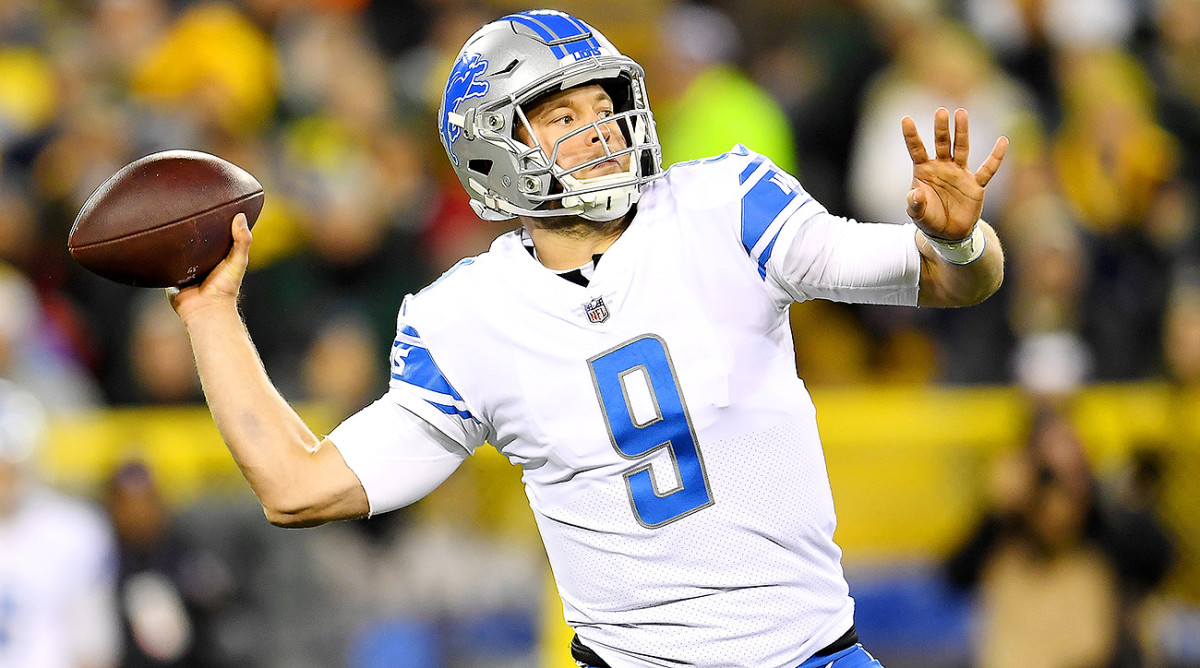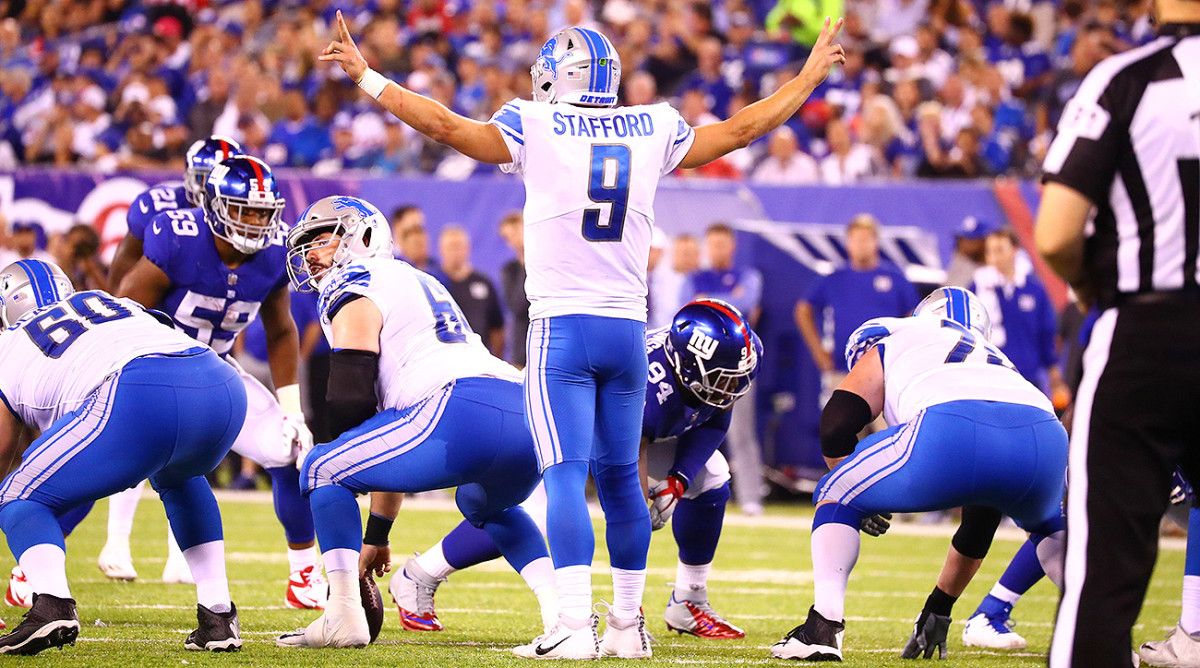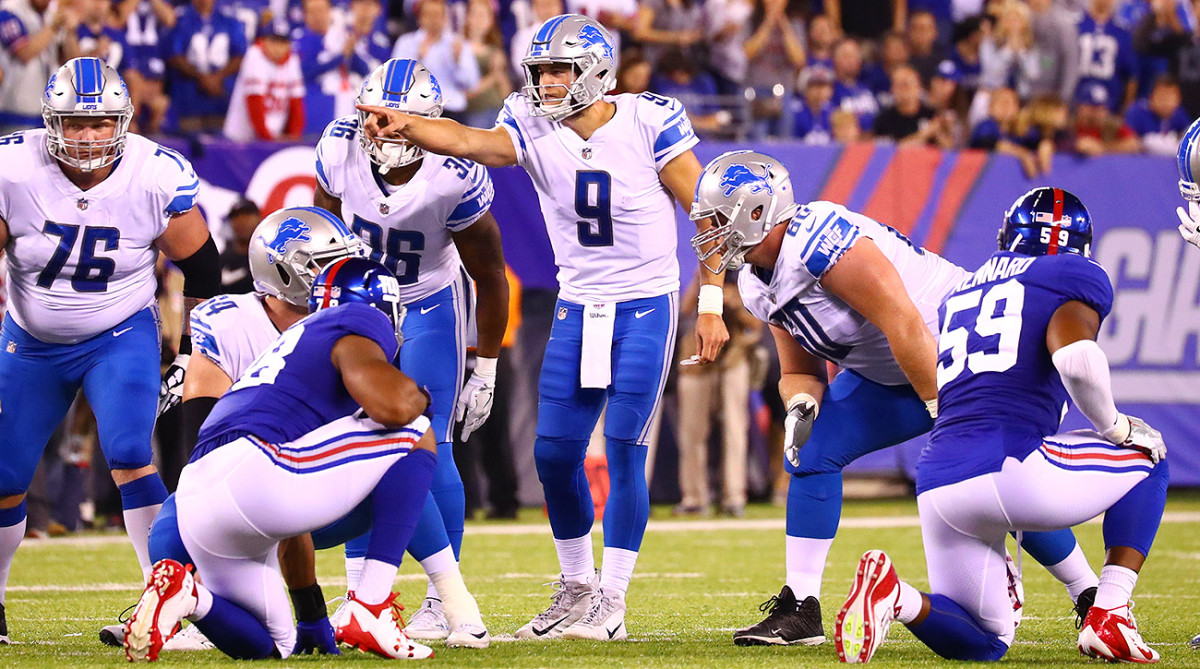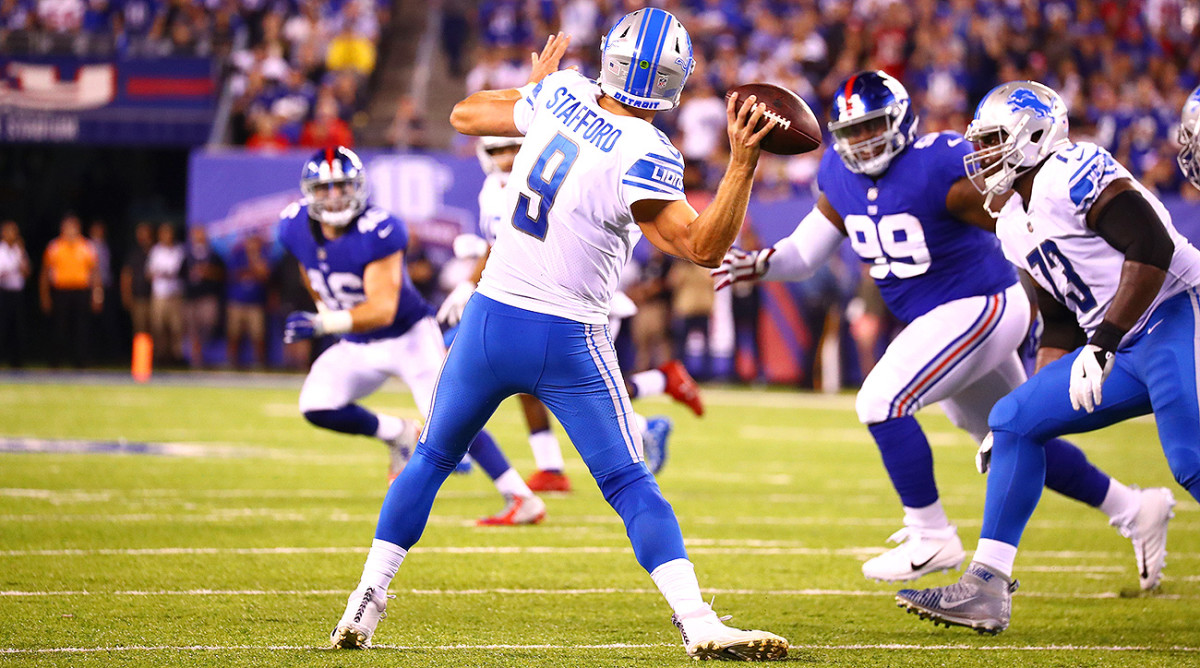Matthew Stafford’s Success a Result of His Drive To Improve—Oh, and That Cannon of an Arm

People talk about Matthew Stafford’s right arm as if he can’t get it through customs without the proper paperwork. The scouting term arm talent seems to have been invented for him. Arm talent includes arm strength, but does not just mean arm strength. In other words, if you lined NFL quarterbacks up on a sidewalk and asked them to throw at the house across the street while running on wet leaves, Stafford is most likely to shatter the right window.
The first time Stafford threw a slant at a Georgia practice, the ball actually whistled. Defensive backs were in disbelief. Receivers became accustomed to his passes dislocating their fingers. After last season, Stafford visited the 3DQB quarterback-training facility in Los Angeles. Adam Dedeaux, one of the instructors, asked Stafford to make a difficult, “off-platform” throw, just to see what he would try. Stafford lowered his arm angle and rifled the pass so hard that Dedeaux started laughing. He had worked with Tom Brady, Matt Ryan and Drew Brees. But he had never seen anybody wing a football like that before.
Longtime NFL quarterback Dan Orlovsky, who backed up Stafford in Detroit, says, “As good as guys like Tom Brady and Drew Brees are, Matthew can do things those guys can’t. And it doesn’t take away from those guys.” Those guys know it, too. Brees has said of Stafford, “He can make some throws that most guys can’t make, or certainly can’t even attempt to make.” The only player who can possibly match Stafford’s arm talent is the Packers’ Aaron Rodgers, and he is now out with a broken clavicle.
Stafford, 29, is starting to rival Rodgers, Brees and Brady in another way: as one of the most valuable players in the NFL. His raw numbers this season (273.4 yards per game, 62.6% completions, 17 touchdowns, five interceptions,)are especially impressive when you look at what surrounds that arm. The Lions have not had a 100-yard rusher in a single game since 2013. They rank 29th in yards per run. They have allowed the fifth-most sacks in the league. Their receivers struggle against press coverage. Yet Stafford has them tied for sixth in the league in scoring.
A native Texan, Stafford projects an understated cool, like a cowboy in a Western; you half-expect a cigarette to dangle from his side-smile. But two years ago, he was struggling more than he ever had, for reasons that seemed to defy logic. His arm was too great. His best receiver was too talented. His obsession was too intense. His coaches did not ask enough of him. He needed his job to get harder before he could make it look easy.
His wife, Kelly, says Matthew “has not changed one bit” since she met him at a movie theater before her freshman year at Georgia. But in the past two seasons his friends have noticed a subtle shift in his mental state. “Completeness is probably a really good word,” Orlovsky says. And Stafford, who is not typically prone to public introspection, says, “There’s been a lot of self-assessment . . . . I feel like I’ve come out the other side a better player, and probably a better person.”

Stafford sits down in the Lions’ practice facility wearing, as usual, a Detroit Tigers hat. He often wears hats backwards, leading people to assume that he doesn’t care about details. They are wrong on both macro and micro levels.
Kelly guesses Matthew has owned 90 Tigers hats since the Lions drafted him with the top pick in 2009. He currently has at least 15 blue ones and five others, and while they are all size 7 5/8", he is picky about the exact fit. He has four in his rotation now. He puts them on only after he showers so they don’t get too dirty. Then he sits down to watch film—taking copious, methodical notes, using different colors to highlight the most important information.
“There is this perception that he is this lazy, doesn’t-really-care, hat-backwards Texas fun-boy,” Orlovsky says. “He is the total opposite.”
The perception starts with the arm. Quarterback may be the most complex position in sports, yet we often describe the stars in the narrowest terms. Tom Brady is a winner. Drew Brees: accurate. Peyton Manning? Nerd. And Matthew Stafford: gunslinger. After he threw his first NFL interception, he got to the sideline and coach Jim Schwartz told him: “Don’t you ever stop slinging it.” Stafford hated committing the turnover but loved Schwartz’s reaction.
“He has such unbelievable God-gifted talent in that arm,” Kelly says. “All he wanted to do was sling it as hard as he could and as far as he could.”
Other QBs picked apart defenses. Stafford tried to set them on fire. He plays “a lot more physical than a lot of quarterbacks—my rookie year, I think I didn’t slide once. I was trying to run people over.”
He was well aware of the Lions’ abominable history—they have won one playoff game since 1957—and of the weapon hanging from his shoulder. Brady and Brees never had his arm, but they also never battled the temptations that came with it. Stafford wanted to show fans something they had never seen in their lives. That meant throwing fastballs, often to All-Pro receiver Calvin Johnson.
“Early in my career, it was first-and-10 on the first play of the game and I thought I needed [a first down],” Stafford says. “Part of that came with, Man, I know what kind of weapon I have on the outside in Calvin. I know where this organization has been. I know where we’re trying to get. Is it going to take this superhuman effort to get there? If it is, I’m willing to give it to you every play.”
There’s never been a combination in NFL history like Stafford and Johnson. Joe Montana’s arm was not as strong as Stafford’s. Jerry Rice was not as big and fast as the 6' 5" Megatron. Johnson could make any catch, Stafford could make any throw, and the Lions built their game plans around them. Stafford says, “Every week was, How can we dial up a way to get Calvin on a safety and throw it? Who is the weak link? Let’s get Calvin on that guy.’”
It worked pretty well for a while. In 2011, when Stafford was 23, he threw for 5,038 yards and 41 touchdowns for a playoff team. But he followed it with a 20-TD, 17-interception season, and Detroit went 4–12. The Lions tried to ease his burden by asking less of him. But Stafford didn’t play better. At times he played worse. There was clearly a franchise quarterback in there somewhere, but some weeks he was hard to find.
By the halfway point of the ’15 season, Stafford could barely reconcile the player he wanted to be with his play. He had a 1–7 record, 11 interceptions, a mediocre 84.1 passer rating and an above-average level of guilt. Schwartz had been fired after 2013, along with Stafford’s first offensive coordinator, Scott Linehan. Then, in 2015, team president Tom Lewand and general manager Martin Mayhew got canned. Stafford was left with “a terrible feeling . . . I hate it.” He thought if he had played better, they would have kept their jobs.
Stafford would come home from losses, walk past the guests who were in from out of town and eat dinner in his bedroom. Sometimes he watched the Sunday night game by himself. Other times, he didn’t even do that. He was such a prodigy in high school that ESPN draft expert Mel Kiper Jr. said he would be go No. 1 in the draft. Three years later the Lions proved Kiper prophetic. Now he was no longer a young quarterback. Fans and local media suggested he visit a private throwing coach. Stafford was insulted. Did Monet need to be taught how to hold a brush?

Kelly had a different suggestion: She wanted kids. He didn’t like that idea, either. He had always teased teammates who had children. You were up all night with a crying baby, huh? Well, I slept great! He told Kelly he had a whole building full of people counting on him. He had all of Detroit. Wasn’t that enough for now?
“I think for people around me, they go, ‘Just have kids. You have enough money to support them, you have enough time to support them, you’re going to be fine,’” Stafford says. “Well, I feel a lot of responsibility for a lot of people around me. Not just Kelly and my family back home in Dallas. There are people working in the Ford plant right now that I feel, on some level, I have some responsibility for them. I was extremely deliberate in the way I thought about it.”
Stafford’s personal life sometimes seems torn from a romance novel: man with the golden arm marries the blonde with the pom-poms. Fans don’t say Stafford married his college sweetheart. They say he married a cheerleader. This grates on Kelly, who played high school basketball and picked up cheerleading at Georgia for “something to do” because she wasn’t good enough for SEC hoops: “I grew up playing so many sports, and the fact I’m known only as a cheerleader just hits me to my core.”
Stafford never saw his life or his wife the way outsiders did. He wanted highlights on the field but a low-key existence off it. He seems incapable of acting like a celebrity. Stafford will not cut the line at Qdoba or Chipotle. He holds doors for people. He rarely forgets a please or a thankyou. Of course, this is how people are supposed to behave. There is no Nobel Prize for door-holding. The point is not that Stafford is special; it’s that he isn’t. His college buddy Hagen Hearn says, “He’s a normal guy with a normal life.” Another college friend, David Koonin, says the Staffords “are the most normal people I know.” Kelly says, “I think being normal is very underrated.”
A doctor had told Kelly that she might not be able to conceive naturally. She persuaded Matthew to start trying. They tried and failed and tried and failed again. At times, they felt like the exact opposite of the star QB and pretty cheerleader. They took months off because it was too stressful.
Work did not provide refuge for either of them. The Lions were losing and Matthew was partly to blame. Kelly had completed nursing school and was working for a plastic surgeon, watching people pursue their own version of perfection. Kelly didn’t know where to steer their dinner conversations. Matthew’s mind seemed like it was elsewhere. She tried not to talk about reproduction, but “then it would end up coming out, and maybe not in the best way. And that’s never good for anyone.”
She had something else she couldn’t discuss: Johnson’s girlfriend, Brittney McNorton, had confided that the star receiver would retire after the season at age 30. Kelly’s reaction: “Selfishly, I was like, Wait, what?” She did not tell Matthew. She thought he should hear it from Johnson.
Matthew got other news first: Midway through 2015, coach Jim Caldwell fired offensive coordinator Joe Lombardi and promoted QBs coach Jim Bob Cooter. It seemed to be an attempt to save the franchise quarterback. Stafford and Cooter added plays on the plane ride to London for a game against the Chiefs. Detroit lost 45–10, but on the flight home Orlovsky looked at his friend and saw “tempered excitement.” Stafford knew what nobody else could see: He had found his offense.
“I had confidence in what Jim Bob was about and what he could do,” Stafford says. “We had to get back on U.S. soil and figure it out.”
Cooter provided a structure that works for Stafford, but the freedom to change plays within it. All those years, the arm had played a trick on everybody: It hid his brain. Stafford is a lot more like Peyton Manning than people realize. He loves having control. Giving him less to do had been a mistake. He thrives with more. In Cooter’s offense, he routinely goes to the line with multiple plays and picks one based on what he sees.
Stafford finished with the best stretch of his career. In eight games he threw 19 TDs and two interceptions as the Lions went 6–2. Near the end of the season Johnson told him he was retiring. Stafford was surprised. But he told Johnson, “Man, I just want you to be happy.” Pretty soon, Stafford would be, too.

At the end of 2016 training camp, his first without Johnson, Stafford went home to his newly renovated lakeside house and settled onto the couch. Kelly had a doctor’s appointment the next day to find out if in vitro fertilization had worked. He asked if she was ready for it. She responded by whistling. On cue, their two dogs, Champ and Marley, walked into the living room. One was wearing a sign that read: GUESS WHAT? The other wore one that read: MOM’S PREGNANT! Kelly had gone to the doctor a day early. She did not want Matthew sitting in the Lions’ facility all day, wondering about the result.
She was pregnant with identical twins. Kelly wanted boys. Matthew wanted girls. He never said why, but Kelly thought she knew: Boys would face more pressure for being Matthew Stafford’s kid. That was too far from normal.
There was no way to know how the news affected his play. But Kelly says, “When you have stress at your job, it can play into your home life and when you have stress at home it can play into your work life.” Matthew was reaching a level of personal and professional comfort that enabled him to excel.
Logically, Stafford should have regressed after Johnson retired. Instead, he has improved. This has very little to do with Johnson and everything to do with Stafford. He spreads the ball around. He isn’t as tempted to wow people. Stafford says, “We don’t have a guy who runs a 4.3 and is 6' 5" and you throw it way down the field a bunch. The way we get those explosive plays now is different than we did back then. I’ve just tried to embrace that.”
The Lions need to win playoff games before Stafford changes public perception. But he is different from the QB he was with Johnson. In 33 games under Cooter, Stafford has an interception percentage of just 1.52%. That is slightly better than the career numbers for Rodgers and Brady. He manages his talent so well now that it’s easy to forget he has so much of it. He still turns passes that would be pick-sixes for others into easy completions, but he also throws the right pass almost every time, with more touch than he once did. He is a nerd in film sessions, accurate during games and late in games when it’s time to win, he becomes a gunslinger again. Last season, he led the Lions to eight comebacks in the fourth quarter or overtime, an NFL record, and a wild-card berth.
“Last year we played 58 minutes of the game and [then] a bunch of times it was just, ‘Hand you the ball, and see what you got, kid,’ ” Stafford says. “That’s a lot of fun.”
Last March 31, Kelly gave birth to twin girls, Chandler and Sawyer. A few weeks later, Stafford visited Dedeaux at 3DQB for his first-ever tutoring session with a private coach. He says the visit helped his career in small ways that fans wouldn’t notice. So have Chandler and Sawyer.

On most fall weekdays, Stafford leaves for work at 5:15 a.m. When he gets home, at 6:30 p.m., he plays with Chandler and Sawyer for 20 minutes, then watches film while Kelly feeds the girls. Together, they read a bedtime story and put the girls down. Then Kelly and Matthew eat dinner together. Then Matthew watches film for another hour before going to sleep and doing it all over again. Playing in the NFL is a blue-collar job with white-collar pay.
If his rise from good player to an excellent one has been stealthy, that is O.K. with him. Stafford deleted his Twitter account. He does not use Facebook or Instagram. Kelly has two Instagram accounts—one for her, one for Chandler and Sawyer—but their seemingly disparate approaches to social media are actually two branches of the same thought. Matthew does not care for the fuss that comes with being an NFL star. Kelly does not like the perception that that is all he is. She says she wants to “to give people a taste into our life,” and so she gives them one spoonful of normal at a time.
It’s funny, looking back: Stafford was doing dad things before he was a dad. He fell asleep on the couch. He read books on work trips. He played golf. He smoked pork butt on his Big Green Egg all day and cooked steaks for guests at night.
The transition to fatherhood was easier and better than he envisioned. The girls have given Stafford a balance he didn’t know he needed. He came home from his first loss of this season—to the Falcons by an inch—and instead of going straight to his room, he went to Chandler and Sawyer. “That was one of the first times it clicked,” he says. His personal happiness and professional success go together. Twins are like a city or a football franchise. You can’t carry them with just one arm.
• Question or comment? Email us at talkback@themmqb.com.
